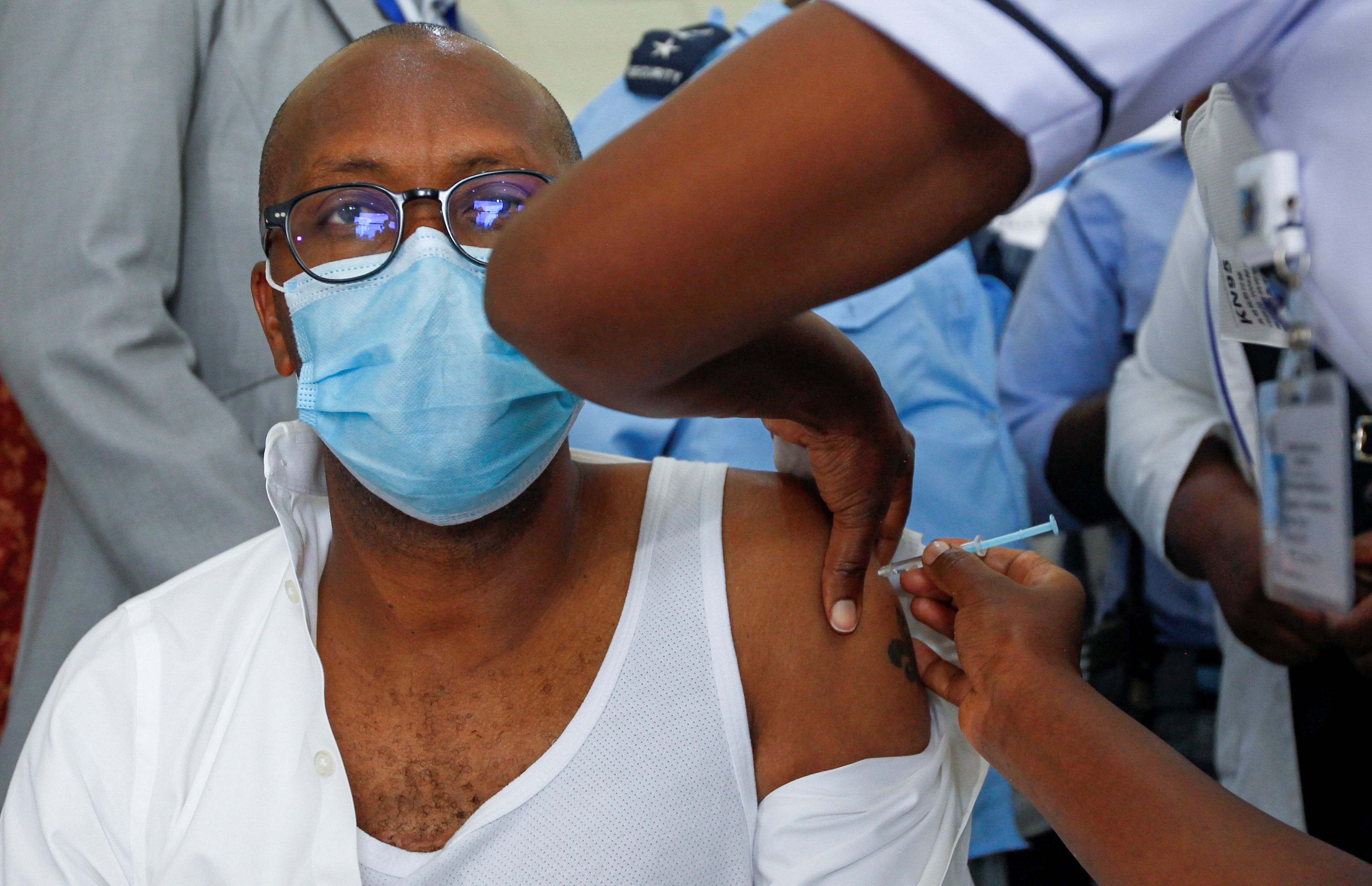Growing Global Inequality: Impact of the COVID-19 Pandemic on Developing Countries
The poorest countries will be the ones most affected by the long-term economic and social effects of the COVID-19 pandemic. Delays in vaccinations and insufficient resources to prompt an economic recovery deepen their poverty. The deepening of economic inequality in the world will lead to destabilisation, increased migration pressure, and difficulties in achieving climate goals. That is why G20 leaders have announced that they will accelerate vaccination campaigns in the poorest countries. The EU can focus on increasing the supply of vaccines to developing countries and the recovery of their economies from the pandemic.
 Photo: MONICAH MWANGI/Reuters/Forum
Photo: MONICAH MWANGI/Reuters/Forum
In 2020, the COVID-19 pandemic spread most rapidly in developed countries. However, this year it has affected developing countries (national income per capita below $12,696) to a greater extent. Of the 250 million confirmed cases of the disease registered worldwide as of 7 November, 58% of the infections (140.4 million) were reported in developing countries where 85% of the global population lives. There were also 3.3 million deaths due to COVID-19, which is 65% of all cases (5.05 million). In addition to the health effects, the pandemic is hitting the economies of the poorest countries hard.
Impact on Economies
According to the IMF, in developing economies, GDP decreased by an average of 2.1% in 2020, while developed economies fell by 4.5% (in the EU, 6.1%; in the U.S., 3.5%). The inflow of foreign direct investment (FDI) to developing countries amounted to $616 billion, a decrease of 12% compared to 2019 (by 30% if excluding China). The collapse of international trade, which declined in value by 6.4% in 2020, mainly affected developing countries. While remittances from emigrants fell by 1.6% to $540 billion in 2020, they provided funds for many families with no other income. The IMF forecasts higher economic growth in 2021 in emerging economies (6.4%) than in developed economies (5.2%).
The economic crisis has had particularly severe consequences for people in developing countries deprived of benefits such as unemployment funding. In 2020, the pandemic wiped out 114 million jobs worldwide, with the greatest losses recorded in lower- and middle-income countries (down 11.3%). Workers’ average wages have fallen in 90% of developing countries. The number of people living in poverty (less than $2 a day) increased by 124 million, from 613 million to 737 million, reversing the positive trend in the fight against extreme poverty for the first time since 1998.
The pandemic has also worsened inequality within developing countries. Women, young people, poorly educated people and economic migrants have been most at risk of losing their jobs and income. The pandemic also disturbed the education of more than 1.6 billion children, of which the poorest countries have faced the greatest problems.
The economic situation is worsened by the lack of own resources to support a recovery. Of $16 trillion in national stimulus packages around the world, only 20% was planned in developing countries. Lower incomes due to the decline in economic activity and greater social spending to mitigate the effects of the crisis have increased the indebtedness of developing countries. According to the World Bank, the debt of the lowest-income countries (LIC) increased in 2020 by 12% to an all-time high of $860 billion, and the debt of all developing countries increased by 5.3% to $8.7 trillion. Developing countries, lacking sufficient financial resources, will feel the effects of the crisis longer.
Unequal Access to Vaccines
Rebuilding developing economies is complicated by the still limited access to COVID-19 vaccines. The vast majority of the 7.28 billion vaccinations administered to date have been in high-income (HIC) and middle-income (UMIC) countries. As a result, while in developed countries over 70% of the population on average had been vaccinated with at least one dose by 7 November, only 39.7% were in lower-middle income countries (LMICs), and only 4.2% in low-income countries (LICs, see Table 1). By the end of September, there were 56 countries where less than 10% of the population had received a single dose. The worst situation is in Africa where only 2.8% of all vaccinations in the world have been recorded, and only 5% of the population has received two doses.
This problem was supposed to be addressed by the international COVAX programme launched in 2020 to facilitate access to vaccines in developing countries. The programme is to provide free vaccinations for at least 20% of the populations of the poorest 92 countries. While the G7 and the EU have promised to deliver 1.8 billion doses of vaccines to the poorest countries through COVAX by the end of 2021, only 435 million doses were actually donated as of 2 November. The programme’s implementation has slowed due to delays in deliveries (including from the main producer in India) and the lack of intermediates for vaccine production.
According to developing countries, an increase in the global supply of vaccines could come from a suspension of patent protections in the WTO, but a proposal by South Africa and India on this issue in autumn 2020 has been blocked, among others, by the EU, which is supporting its pharmaceutical companies (the U.S. conditionally supported the move in May this year). In addition to the paucity of vaccines, the vaccination programmes in developing countries have also been delayed by the lack of effective storage and distribution systems, including trained personnel and efficient logistics.
International Reaction
As early as April 2020, G20 members promised to increase financial assistance to LICs and announced an initiative (DSSI) to temporarily suspend their debt payments to the end of 2021. However, they have not agreed on debt cancellation. Official development aid from major donors rose to a historic level of $161.2 billion in 2020 (3.5% more than in 2019), of which $12 billion was intended for the fight against COVID-19. In addition, the World Bank has transferred $157 billion since the beginning of the pandemic to combat its effects, and the IMF has allocated $117 billion for aid in 85 countries and debt relief in 29 LICs. In July this year, the IMF issued for only the fourth time in its history Special Drawing Rights (SDRs) worth $650 billion to provide liquidity and facilitate the recovery of economies from the pandemic. The SDRs were allocated in accordance with the shares in the IMF, hence only $275 billion went to developing countries, including only $21 billion to LICs.
The EU plays an important role in the fight against the pandemic. Under the banner “Team Europe” (EU institutions and the Member States), it transferred as of April this year €34 billion to fight COVID-19 (out of a promised €46 billion). It also allocated more than €3 billion to COVAX, more than any other country or organisation, including the U.S. After securing supplies for national vaccination programmes, the European Commission promised to provide 500 million doses of vaccines in the form of a grant to developing countries by the end of this year and an additional 500 million by mid-2022. The problem, however, is the slow pace of fulfilling these promises—as of 19 October, it had provided only 57 million doses.
The late start and lengthy fulfilment period by the EU and the U.S. have made China the main supplier of vaccines to developing countries. The Chinese government reports that as of October, it had sold 1.2 billion doses to developing countries, and between 57 million (UNICEF data) and 90 million (BridgeBeijing website) doses had been provided as donations.
Conclusions and Perspectives
The COVID-19 pandemic has stalled progress in the fight against poverty in the world and is increasing economic inequality between developing and developed countries. The deterioration of the economic situation and a possible debt crisis in poor countries raises the risk of greater political instability, regional conflicts, and stronger migration pressure. It also has reduced the resources to combat climate change and achieve Sustainable Development Goals (SDGs). According to the UNDP, COVID-19 will delay the fulfilment of the SDGs by 10 years unless decisive action is taken now. The course of the pandemic in the poorest countries also increases the risk of mutations that can in turn spread to developed countries, which may again increase the number of infections there.
Hence, the leaders of the G20 at the October summit in Rome announced an “increased supply” of vaccines to vaccinate at least 40% of the populations of all countries by the end of this year and 70% by mid-2022. However, they did not identify additional ways to achieve these goals and support the economic recovery of the poorest countries. The EU should accelerate the implementation of its own vaccine donation commitments and use development aid and climate funds to support investment in the poorest countries. It may also promote the cancelation of debts of low-income countries and consider suspending patent protection for COVID-19 vaccines. Poland may also increase aid to fight the pandemic by providing partners with subsequent batches of vaccines (in addition to those its already sent, such as the 1 million doses to Iran) and increasing contributions to COVAX.
Table 1. Incidence of COVID-19 and Vaccinations by Country (grouped by income)
|
|
High- Income Countries (HIC) |
Upper-Middle- Income Countries (UMIC) |
Lower-Middle- Income Countries (LMIC) |
Low- (LIC) |
Developing countries (UMIC+LMIC+LIC) |
Global |
|
Population (2020, millions) |
1,215 (15.6%) |
2,514 (32.4%) |
3,331 (43%) |
665 (9%) |
6,510 (84.4%) |
7,753 |
|
COVID19 infections (millions) |
106.25 (42.4%) |
79.76 (31.8%) |
62.5 (25.3%) |
1.36 (0.55%) |
140.31 (57.6%) |
250.37 |
|
Deaths due to COVID-19 (millions) |
1.77 (35%) |
2.13 (42%) |
1.12 (22%) |
0.036 (0.7%) |
3.28 (65%) |
5.05 |
|
Share of population which have had at least one dose of a vaccine |
72.1% |
71.3% |
39.7% |
4.2% |
- |
51.09% |
|
Share of population fully vaccinated |
65.62% |
62.87% |
22.05% |
2.24% |
- |
39.7% |
|
As of 7 November 2021. Sources: World Bank, World Development Indicators; World Health Organisation, Our World in Data (https://ourworldindata.org/). According to the World Bank classification: LIC are countries with Gross National Income (GNI) per 1 citizen below $1,045; LMIC have GNI per capita between $1,046 and $4,095; UMIC have GNI per capita between $4,096 and $12,695; and HIC have GNI per capita above $12,696. |
||||||


